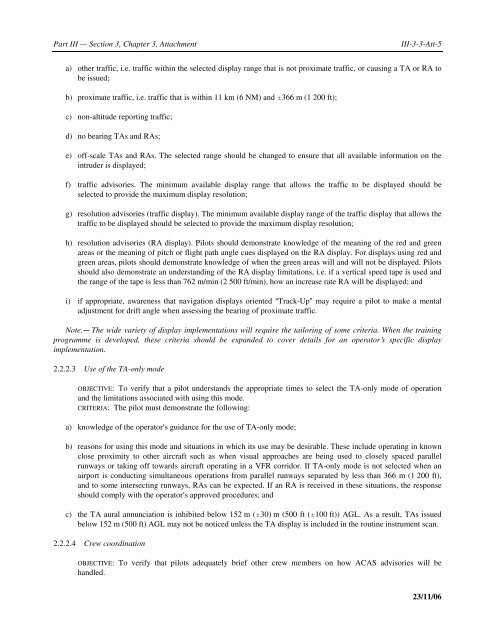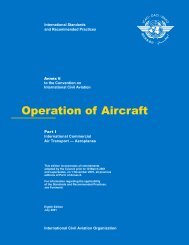Aircraft Operations
Doc 8168 Aircraft Operations, Volume I Flight Procedures
Doc 8168 Aircraft Operations, Volume I Flight Procedures
- No tags were found...
Create successful ePaper yourself
Turn your PDF publications into a flip-book with our unique Google optimized e-Paper software.
Part III — Section 3, Chapter 3, Attachment<br />
III-3-3-Att-5<br />
a) other traffic, i.e. traffic within the selected display range that is not proximate traffic, or causing a TA or RA to<br />
be issued;<br />
b) proximate traffic, i.e. traffic that is within 11 km (6 NM) and 366 m (1 200 ft);<br />
c) non-altitude reporting traffic;<br />
d) no bearing TAs and RAs;<br />
e) off-scale TAs and RAs. The selected range should be changed to ensure that all available information on the<br />
intruder is displayed;<br />
f) traffic advisories. The minimum available display range that allows the traffic to be displayed should be<br />
selected to provide the maximum display resolution;<br />
g) resolution advisories (traffic display). The minimum available display range of the traffic display that allows the<br />
traffic to be displayed should be selected to provide the maximum display resolution;<br />
h) resolution advisories (RA display). Pilots should demonstrate knowledge of the meaning of the red and green<br />
areas or the meaning of pitch or flight path angle cues displayed on the RA display. For displays using red and<br />
green areas, pilots should demonstrate knowledge of when the green areas will and will not be displayed. Pilots<br />
should also demonstrate an understanding of the RA display limitations, i.e. if a vertical speed tape is used and<br />
the range of the tape is less than 762 m/min (2 500 ft/min), how an increase rate RA will be displayed; and<br />
i) if appropriate, awareness that navigation displays oriented Track-Up may require a pilot to make a mental<br />
adjustment for drift angle when assessing the bearing of proximate traffic.<br />
Note. The wide variety of display implementations will require the tailoring of some criteria. When the training<br />
programme is developed, these criteria should be expanded to cover details for an operators specific display<br />
implementation.<br />
2.2.2.3 Use of the TA-only mode<br />
OBJECTIVE: To verify that a pilot understands the appropriate times to select the TA-only mode of operation<br />
and the limitations associated with using this mode.<br />
CRITERIA: The pilot must demonstrate the following:<br />
a) knowledge of the operators guidance for the use of TA-only mode;<br />
b) reasons for using this mode and situations in which its use may be desirable. These include operating in known<br />
close proximity to other aircraft such as when visual approaches are being used to closely spaced parallel<br />
runways or taking off towards aircraft operating in a VFR corridor. If TA-only mode is not selected when an<br />
airport is conducting simultaneous operations from parallel runways separated by less than 366 m (1 200 ft),<br />
and to some intersecting runways, RAs can be expected. If an RA is received in these situations, the response<br />
should comply with the operators approved procedures; and<br />
c) the TA aural annunciation is inhibited below 152 m (30) m (500 ft (100 ft)) AGL. As a result, TAs issued<br />
below 152 m (500 ft) AGL may not be noticed unless the TA display is included in the routine instrument scan.<br />
2.2.2.4 Crew coordination<br />
OBJECTIVE: To verify that pilots adequately brief other crew members on how ACAS advisories will be<br />
handled.<br />
23/11/06












